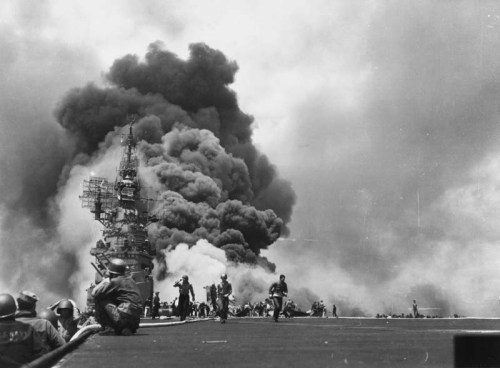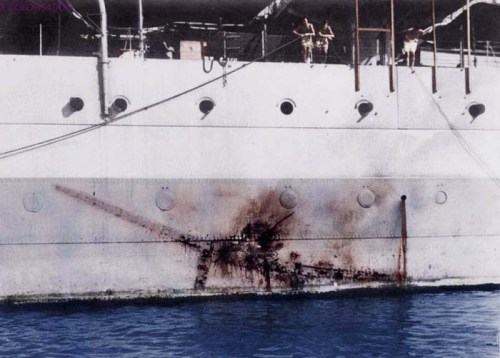Last time we looked at the Romano-Scottish discussions of 148 AD about the height of the New Wall . Some limited progress was made towards a solution: As promised, though, here is “Where’s Wally?” on his visit to a famous battlefield, the “Battle of the Little Bighorn” where George Armstrong Custer finished a close second to the Lakota warriors led by Crazy Horse and Tatanka Yotanka or Sitting Bull :
As promised, though, here is “Where’s Wally?” on his visit to a famous battlefield, the “Battle of the Little Bighorn” where George Armstrong Custer finished a close second to the Lakota warriors led by Crazy Horse and Tatanka Yotanka or Sitting Bull :

Wally takes some finding because he hasn’t got his usual shirt. Instead he is masquerading as a Lakota horseman on the far left of the picture. Bare chested, he has been forced to paint his skin with his trademark hoops, on this occasion in blood red:
 Today though, I wanted to tell you about some pictures which were very important to me as a child, as I ploughed through the ten volumes of the Arthur Mee’s Encyclopedia which had been owned by my Dad when he was a boy in the early 1930s. Arthur Mee was a wonderful contributor to the education of children:
Today though, I wanted to tell you about some pictures which were very important to me as a child, as I ploughed through the ten volumes of the Arthur Mee’s Encyclopedia which had been owned by my Dad when he was a boy in the early 1930s. Arthur Mee was a wonderful contributor to the education of children:

The encyclopedias contained a good deal about dinosaurs. I was very struck by the picture of Mary Anning, the 11 year old girl who, in 1811, found the first ever ichthyosaur skeleton:
 I hadn’t realised what an incredibly hard life Mary had. She was oppressed for six things she couldn’t help. She was working class. She was poor. She was a Dissenter, a group who were not members of the Church of England. Her father died when she was eleven. She was a woman. Furthermore she was not allowed to join the Geological Society, because she was working class, poor, a Dissenter and a woman.
I hadn’t realised what an incredibly hard life Mary had. She was oppressed for six things she couldn’t help. She was working class. She was poor. She was a Dissenter, a group who were not members of the Church of England. Her father died when she was eleven. She was a woman. Furthermore she was not allowed to join the Geological Society, because she was working class, poor, a Dissenter and a woman.
I didn’t ever realise that, in order to supplement her income, Ann used to sell those delightful Henry de la Beche scenes from prehistoric life. There were some beautiful ones in Arthur Mee’s “Children’s Encyclopædia”:

The first image occupied only the top part of the page, and on the lower half there was a representation of the fossils created by those splendid creatures:

To help children learn the names of the dinosaurs, they were added to the second picture. There were Ammonites, Cetiosaurus, Chelonian, Rhamphorynchus, Scelidosaurus and Teleosaurus. Go on, have a go, you know you want to!
Every volume of the Arthur Mee encyclopedia had a full colour frontispiece. For this volume, not surprisingly, there was a picture of an Iguanodon. It is probably the most striking image of my childhood:

I love the way that this iguanodon has exactly the same enigmatic smile as the Mona Lisa. And as an added bonus, his eyes follow you all round the room, just like the world’s greatest artists do in all their pictures. Such greats as Michelangelo. Raphael. Leonardo. And Donatello.

























 The person who impressed me most, though, was the villainous Sheriff of Nottingham who was played by Alan Wheatley. I was unable to find the relevant card from the “WHO-Z-AT-STAR?” series. The one I admired as a little boy had the Sheriff wearing his leather jacket covered in metal studs. Here’s the jacket in a still from the TV series:
The person who impressed me most, though, was the villainous Sheriff of Nottingham who was played by Alan Wheatley. I was unable to find the relevant card from the “WHO-Z-AT-STAR?” series. The one I admired as a little boy had the Sheriff wearing his leather jacket covered in metal studs. Here’s the jacket in a still from the TV series:




 Here’s a beautifully made lump of stone on a stick:
Here’s a beautifully made lump of stone on a stick:






